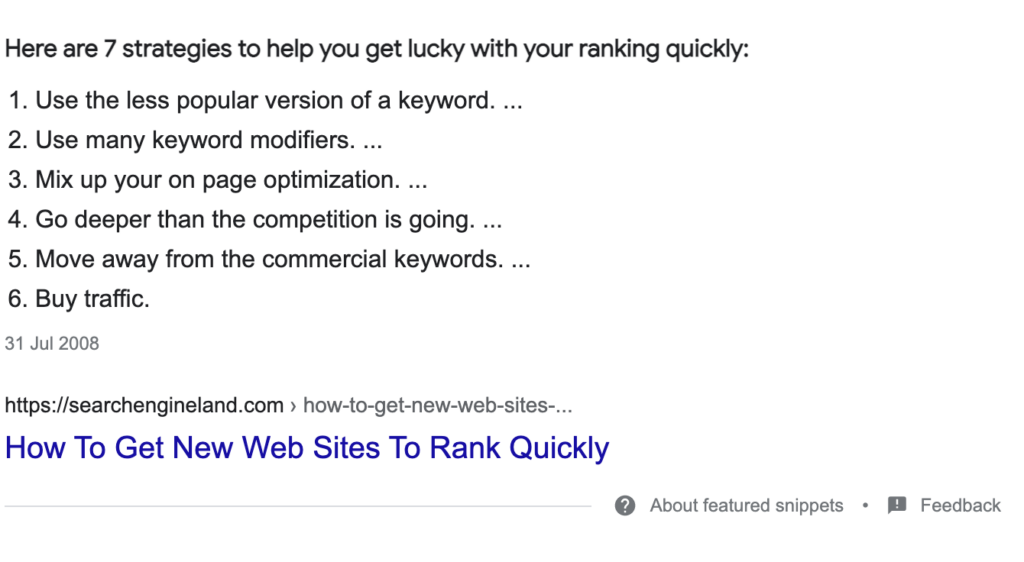I assume you already have your priority keywords on your main product and services pages. If that’s the case, the next step is to start or grow your website. Creating new pages, often by the use of a blog is often the only way to grow a website, each page targeting one or a cluster of keywords.
Airbnb and Paypal started with blog posts before they bagged their enterprise level brand searches and could relax relying on technical SEO. Even if you can’t see a link to a blog on your competitor’s home page, it’s likely there will be stacks of pages targeting volumes of keywords and keyword phrases somewhere.
1. Choose a great revenue-generating keyword
Choose a great phrase that means something to a searcher who may become a customer. Consider ‘North London bakery’ versus ‘how to make bread’. The first has more business value. High traffic and low keyword difficulty keywords are ideal starting points.
Create a list of additional keywords around this term, which may be less searched for or may be terms you don’t regularly use, but which your customers might use.
One B2B client I consulted for sold toys wholesale to retailers, but had missed the term ‘cash and carry’ anywhere on their site, their competitors had been cleaning up search traffic for years.
2. Keep paragraphs neat and tidy
Paragraphs with 2-3 sentences is ideal. This will help readers jump down the page like stepping stones. Before they realise, they will reach the end. Bounce rate is higher when searchers are faced with a lengthy paragraph at the top of the page. Who wants to burn the calories?
3. Don’t trust automated CMS URLs
Numerous studies over the years have found shorter URLs with their keyword close to the main domain rank better. This is still the case even if, as is often the case these days, Google isn’t showing the full one in the SERPs. And if there’s stiff competition for your keyword, you can steal clicks from higher ranking competitors if you’re relevant enough.
Here are 2 example URLs in the SERPs for a search query ‘how to make sour dough’
https://www.bakingwithmary.com/recipes/guides/learning-how…
https://www.bakingwithjohn/sour-dough-recipe
It’s a no brainer you will click on John’s URL. It’s giving you what you want immediately, whereas Mary is forcing you to second guess what her page is offering.
Don’t let your CMS automate your URL for you. Get stuck in, create your own and grab traffic.
4. Treat your meta description like a paid Google ad
I know, I know. Google won’t always show the description you’ve pulled together but when it does, make sure it’s going to lure your searchers in. I have wondered if it is because we’re not paying Google for the description that so many business don’t invest in it.
Space is tight, but if you can squeeze in a call to action – do it!
Here’s a good example for formal men’s wear with a strong CTA from TKMax:

5. Can you double your traffic with one backlink?
When it comes to internal pages, I have seen many times how it would be possible to rank in position one with one link. All other metrics comparable, if Google’s not sure and all other methods are exhausted, links will usually win the day.
Your internal page focusing on keyword X might not be the focus of even the strongest competitor who may have no backlinks to their internal page. It is still possible for the most humble of websites to steal rankings and traffic from an enterprise competitor because of the fact they are immense and cannot waste time cherry picking internal pages to backlink.
If you were a market leader with a ten million page website – would you? You might not even need a particularly great backlink to climb above them to steal the top position.
Worried about penalties? For one or two backlinks – it would be an extremely rare occurrence to be penalised. I’ve never heard come across it or at least there would have to be a whole lot of other stuff going on with your site.
Best case, you get more traffic. Worst case? Nothing happens, or Google ignores the links now it’s official Google is choosing to nullify spammy links over penalisation.
6. Don’t forget internal linking to pass link juice

Link to your new page from other high traffic/high authority pages on your site. Many studies have found a link from home page navigation or footers can boost rankings ten-fold by passing what is called ‘link juice’ through to your weaker pages, although Google, not surprisingly disputes this.
7. Use relevant anchor text to fight tough competition

Numerous studies over the years suggest that relevant anchor text makes it easier for Google to retrieve your internal page. 100 backlinks with ‘car insurance loans’ anchor text pointing at a page selling home insurance just doesn’t make sense.
In the screenshot above the site purpalyndigital is ranking well against some stiff competition from the website Backlinko despite only two backlinks from zero authority sites.
7. Think past the SEO tools
According to ahrefs, there are only 20 monthly searches in the UK for the phrase “how to rank a keyword fast”, the purpalyndigital blog post receives none. But what if a searcher in the UK has read the posts by the leading sites and has got them thinking about outsourcing the work?
They remember the agency name purpalyndigital which stood out when it appeared in the SERPs, (because they commented on the awful name to a colleague), made a brand search, completely forget about the article they were looking for and make an enquiry.
SEO tracking and tools can only tell you so much, after doing your research, sit back to consider (i) what the searcher’s intent might be for your chosen keyword (ii) how accurate the tools are and (iii) human behaviour in the real-world.
“I don’t follow the crowd. I move through them.”
– Unknown
8. Try to bag a featured snippet

And don’t forget to play around with Schema mark-up if you can. The screenshot of the snippet above is featuring an article with only 7 strategies and is over 10 years old.
